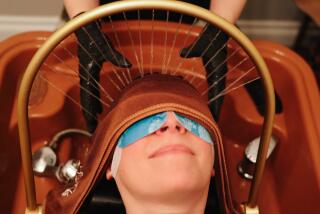Legal Status in 30 States : Americans Get the Point: Some Try Acupuncture
- Share via
GETTYSBURG, Pa. — Desperate for relief from rheumatoid arthritis, Karen Greubel tried everything medicine had to offer before turning, somewhat skeptically, to acupuncture. She’s now a believer.
“If I mention it to people who just aren’t familiar with it, they think it’s all hocus-pocus and not based on anything,” said Greubel, a 33-year-old registered nurse at Washington Hospital Center in Washington, D.C.
Not only has acupuncture relieved much of the pain, it’s made her a better, happier person. “I’m more focused, just a little less hyped up,” she said by phone from The Centre for Traditional Acupuncture in Columbia, Md.
Subject of U.S. Studies
Many Americans are turning to the ancient Chinese practice, legally recognized now in about 30 states and the subject of federally funded studies, said Robert Duggan, president of The Traditional Acupuncture Institute, also in Columbia. An estimated 5,000 to 5,500 people are qualified to practice in the United States, said Duggan, and 1,500 to 2,000 physicians occasionally incorporate acupuncture into their conventional practices.
“The hysterical quality of acupuncture has passed, and physicians are willing to look at it and consider seriously how they can incorporate it into their medical practices,” said Dr. Joseph Helms, an internist from Berkeley, Calif., who is president of the American Academy of Medical Acupuncture.
Acupuncture, documented by the Chinese for more than 2,500 years, involves the insertion of fine needles to regulate flows of electro-magnetic energy in the body, what the Chinese refer to as qi or ch’i. The Chinese believe these flows influence the functioning of the hormones, nerves, blood and organs.
Another example of this is Chinese hand exercise balls, which can be found advertised in some U.S. magazines. The balls are said to stimulate various acupuncture points and thereby relieve fatigue and worry.
Process Not Understood
The 360 acupuncture points also can be stimulated through massage and “moxibustion,” in which slow-burning sticks of herbs are held just above the skin.
“It’s very clear . . . that it has a physiological base” although no one clearly knows how or why, Duggan said.
Acupuncture attracts Americans from all walks of life and ethnic backgrounds, according to Peter Marinakis, a psychologist-turned-acupuncturist who serves on the board of directors of the American Assn. of Acupuncture and Oriental Medicine. “More people are being turned away by Western care.
“There are many, many cases where allopathic medicine can’t help people and we’re winding up with those patients.”
Last Resort for Some
About half of those seeking treatment at The Centre for Traditional Acupuncture suffer from long-term chronic pain or illness and see acupuncture as a last resort, Duggan said. The rest want to preserve their health.
About 15,000 treatments are performed each year at the Columbia center, one of the largest and oldest in the United States, Duggan said. Another 5,000 are performed at the affiliated institute, where students are trained.
“It really has its best value in dealing with problems that don’t give any laboratory readings or probably if you’d take a biopsy wouldn’t show anything grossly abnormal . . . things just aren’t working right, people don’t feel up to par,” Helms said.






